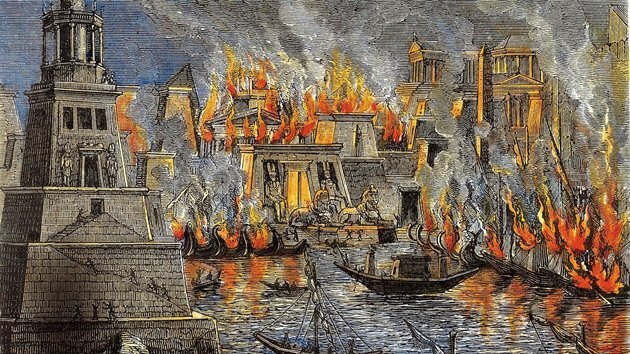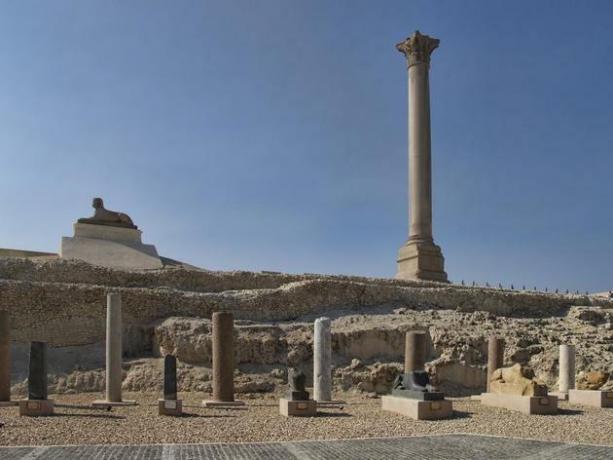THE Alexandria Library it was founded in the III century; a., in the city of Alexandria, that formed part of the Macedonian empire.
It was in operation for six hundred years and was permanently destroyed between the years 250 and 270.
Creation of the Library of Alexandria
The city of Alexandria was founded in 331 BC. Ç. by Alexander the Great. The Macedonian king himself chose its location, drew up the urban layout and named it after him.
The library was the idea of the first Greek king Ptolemy I (366 a. Ç. - 283 a. C.), successor of Alexander. He is also known for creating the first museum in history, named after the Muses.

Currently, the definition of a library is a place that stores books and publications. However, it had a research institute, ten laboratories, a zoo, a botanical garden, an astronomical observatory and resting places. Therefore, many scholars consider it the first university that ever existed.
In the philosophical field, the School of Alexandria intended to rival the School of Athens. They were concerned with spreading the neoplatonism and Aristotelianism.
The kings of Egypt generously supported the library. Emissaries were sent to buy manuscripts in all languages, and the papyruses that arrived with merchants at the port of Alexandria were copied and returned to their owners.
During the reign of Cleopatra, it is estimated that the library gathered around 1 million scrolls.
Destruction of the Library of Alexandria
The Library of Alexandria suffered a great fire in the year 48 a. Ç. when Emperor Julius Caesar ordered the city to be attacked.
However, in the second century, Alexandria also suffered popular rebellions that ended up destroying its heritage.
The loot produced by the Roman Emperor Caracalla (188-217), in the year 215, makes it clear that the library suffered loss of material at this time.

Likewise, an earthquake in the year 365 razed part of the building. On this occasion, 40,000 scrolls were transferred to a smaller library in the Temple of Serapis. This was a brilliant measure, as part of the collection that has come to our days comes from there.
When Christianity became the official religion of the Roman Empire, the library was invaded and set on fire by Christians who destroyed books that were not in accordance with their faith.
With its end, very important works were lost, such as plays by Aeschylus, Euripides and Aristophanes and the astronomy treatise by Aristarchus of Samos. This scholar claimed that Earth was another one of the planets in orbit, that the stars were very distant and were moving slowly, for example.
Another loss was the writings of the playwright Sophocles, because of his 123 works, only seven reached our time, as Oedipus King.
Ruins of the Library of Alexandria

Today, there are no traces of the complex of buildings where the Library, Museum and research institute used to be.
However, it is possible to visit the ruins and some tunnels of the Temple of Serapis (Serapeu) where books that belonged to the library were kept.
Alexandrian Library Scholars
By amassing a huge amount of manuscripts, the library attracted sages from various parts who taught and researched there. Let's look at some of them:
- Euclid of Alexandria – systematized geometry and authored a treatise that dominated the teaching of mathematics for over two thousand years.
- Dionysus of Thrace – defined grammar and established a way of studying language by distinguishing verbs, nouns, etc.
- Archimedes – physicist, mathematician and inventor, was the first to describe the use of the lever, created mathematical formulas for infinite sums, in addition to the "Aspiral of Archimedes".
- Hipparchus – Greek mathematician and astronomer, made a map of the constellations, measured the brightness of the stars and calculated the division of the day into 24 hours.
- Ptolemy – an astronomer who claimed that the Earth was the center of the universe and was also static.
- Herophile – regarded as the first anatomist, described the blood vessels, the structure of the brain, and identified it as a place of intelligence rather than the heart. His anatomy treatises were lost in the fires, but his studies came to us through Galeano.
- Hypocia – Philosopher, astronomer and mathematician, Hypatia of Alexandria was a scholar who taught and researched natural phenomena. None of the books that Hypatia wrote have survived to this day; however, those she made with her father, the philosopher Theon of Alexandria, survive.
Curiosities
- Alexandria was the second city of the Roman Empire and was home to 500,000 inhabitants.
- In 2003, Egypt opened a modern library in Alexandria whose architecture resembles the solar disk.
read more:
- Alexander the Great the Great
- ancient philosophy
- Roman Empire

